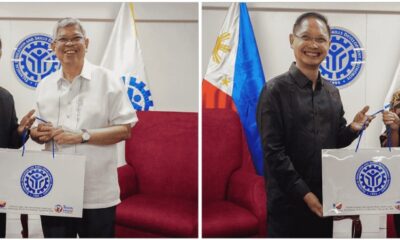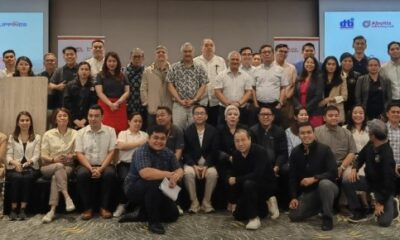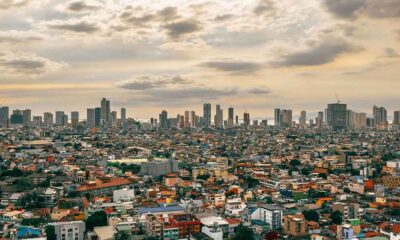Business
Metro Manila Subway Breaks Ground
The country’s first underground railway system, the Metro Manila Subway, officially broke ground Wednesday, 27 February 2019, in Barangay Ugong here.
Executive Secretary Salvador Medialdea led the groundbreaking ceremony, together with Japanese Ambassador to the Philippines Koji Haneda, and Department of Transportation (DOTr) Secretary Arthur Tugade.
Secretary Tugade said many sectors did not believe when they announced that they are doing the Subway.
To signify the start of the project, Executive Secretary Medialdea, Ambassador Haneda, Secretary Tugade, members of the Cabinet, and local government officials led the unveiling of the scale model of the Tunnel Boring Machine (TBM), along with the ceremonial shoveling of the ground where the subway’s depot will stand.
Medialdea and Ambassador Haneda also simulated the construction of the subway through the operation of a backhoe machine.
“We will deliver this to the Filipino people as fast as we can, as well as we can, and without any whiff of corruption,” Executive Secretary Medialdea said.


DOTR Sec. Arthur Tugade led the groundbreaking of the Metro Manila Subway, Wednesday, Feb 27 in Barangay Ugong, Valenzuela City. With him are Japanese Ambassador to the Philippines Koji Haneda and other government officials. (Photo courtesy of DOTr)
The DOTr, in collaboration the Housing and Urban Development Coordinating Council (HUDCC), National Housing Authority (NHA) and the City Government of Valenzuela awarded Informal Settler Families (ISFs) that will be affected by the construction of the Subway with certificates of entitlement for their relocation to Disiplina Village II, Barangay Bignay, also in Valenzuela City.
Tugade presented the certificates to 20 out of 183 beneficiary families. The remaining 163 families are undergoing pre-qualification process.
The country’s first-ever subway system will be composed of 15 stations from Quirino Highway in Quezon City to NAIA Terminal 3 in Pasay and FTI in Taguig, all connected through a 36-kilometer rail line.
Set to run at 80 kilometers per hour, the Subway will cross seven local governments and pass through three of Metro Manila’s business districts in just 30 minutes.
Guided by Japan’s expertise in railways, the Metro Manila Subway will feature technological advancements and disaster-resilient strategies aimed to boost the Subway’s structural integrity amid regular occurrence of typhoons and earthquakes.


DOTr Sec. Tugade and Valenzuela City Mayor Rex Gatchalian awarded Informal Settler Families (ISFs) that will be affected by the construction of the Subway with certificates of entitlement for their relocation to Disiplina Village II, Barangay Bignay, also in Valenzuela City. Certificates were awared to 20 out of 183 beneficiary families. The remaining 163 families are undergoing pre-qualification process. (Photo courtesy of DOTr)
The Metro Manila Subway is set to commence partial operations by 2022 for its first three stations (Quirino Highway – Mindanao Avenue Station, Tandang Sora Station, and North Avenue Station), while the entire rail line will be fully operational by 2025.
The pioneering underground rail line is expected to serve 370,000 passengers daily in its first year of full operations, with a design capacity that can accommodate up to 1.5 million passengers per day.
Just last week, the DOTr signed the contract for the design and build of the Partial Operability Section with the Joint Venture of Shimizu Corporation, Fujita Corporation, Takenaka Civil Engineering Co., Ltd., and EEI Corporation.
The Partial Operability Section is comprised of the first three stations, the depot in Valenzuela, and structures for the Philippine Railway Institute (PRI) that will be the primary policy-making body for the Subway.
“Nang nakita namin ang kultura ng mga taga-Japan, sabi ko, magkakaroon din tayo ng Philippine Railway Institute, sapagkat ‘yung pagbuo ng PRI ay dapat may kaakibat na training, skills, talent, at culture of belonging and love for the job,” Tugade said.
DOTr Undersecretary for Railways Timothy John Batan, said each subway station will feature an intermodal facility that will make transfers to and from road-based transport seamless and convenient.
Further, the Metro Manila Subway will be connected with other major rail lines such as the PNR Clark, PNR Calamba, and the Common Station to ensure interconnectivity, intermodality, and interoperability.
The construction of the Metro Manila Subway is a collaborative effort with the Government of Japan through a PhP365-billion Official Development Assistance (ODA) loan from the Japan International Cooperation Agency (JICA).
“We support the Philippines in shifting the ‘Build, Build, Build’ Program to higher gear. With cutting-edge technology, the Philippines can count on Japan’s extensive experience in railway operations. Together, there is no stopping Japan and the Philippines in achieving more,” Ambassador Haneda said during the launch.
Also present during the groundbreaking ceremony were Budget and Management Secretary Benjamin Diokno, Public Works and Highways Secretary Mark Villar, National Economic and Development Authority Director-General and Socio-Economic Planning Secretary Ernesto Pernia, Senator JV Ejercito, JICA Philippines Chief Representative Yoshio Wada, Philippine National Railways (PNR) General Manager Junn Magno, Valenzuela City Mayor Rexlon Gatchalian, representatives of the Shimizu-Fujita-Takenaka-EEI Joint Venture, and other officials from the public and private sectors. (PIA InfoComm)

































